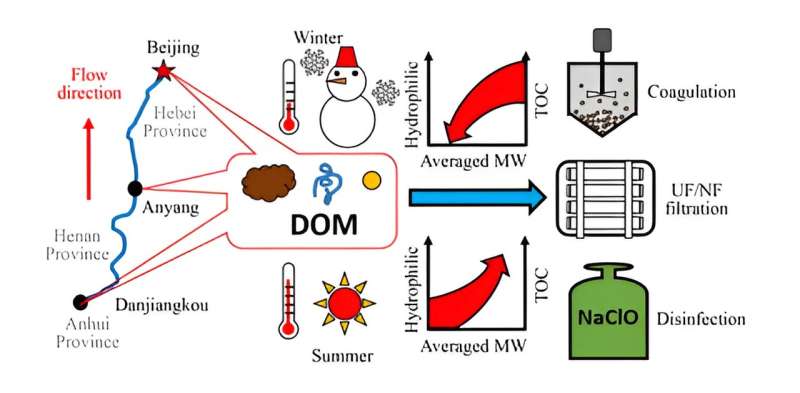This article has been reviewed according to Science X's editorial process and policies. Editors have highlighted the following attributes while ensuring the content's credibility:
fact-checked
proofread
How China's massive water transfer shapes drinking water quality

Dissolved organic matter (DOM), originating from both natural and human activities, is a complex mixture of organic substances that can vary by season, location, and environmental conditions. DOM impacts the coagulation process, membrane fouling, and the potential for disinfection by-product (DBP) formation, necessitating dynamic water treatment adjustments to maintain compliance with drinking water standards.
In an article published in the Frontiers of Environmental Science & Engineering, a team of scientists from the Chinese Academy of Sciences and Imperial College London detail their examination of the significant seasonal variations in water quality within the monumental China South-to-North Water Diversion project.
These variations, largely due to fluctuations in DOM, pose a substantial challenge to the effectiveness of water treatment processes. The researchers are working to optimize these strategies to ensure the delivery of high-quality drinking water and to minimize the formation of harmful DBPs.
In this detailed study, researchers traced the path of water along the South-to-North Water Diversion Project, one of the most ambitious engineering endeavors globally, designed to tackle northern China's severe water shortages.
By analyzing water samples collected from the project's central route during different seasons, the team focused on the intricate changes in DOM, which plays a crucial role in water quality and treatment efficacy. The research revealed that DOM undergoes significant transformations as it travels long distances, influenced by factors such as seasonal variations and geographical changes.
In summer, polysaccharides tend to accumulate, impacting the ultrafiltration process used in water purification, whereas in winter, a different set of challenges arises with the formation of potentially harmful disinfection by-products. These seasonal dynamics affect how water treatment plants must operate to effectively remove contaminants and ensure the water remains safe for consumption.
Dr. Wenzheng Yu, the lead author of the study, said, "Our research offers unprecedented insight into how the characteristics of dissolved organic matter evolve during their journey in a long-distance water transfer system. This understanding is key to optimizing water treatment processes and ensuring safe drinking water."
Findings from the study are critical for water treatment facilities using the South-to-North Water Diversion, providing them with the knowledge to adjust treatment processes according to seasonal variations in DOM. This could lead to more efficient water treatment methods and safer drinking water for millions of people.
More information: Hankun Yang et al, The variation of DOM during long distance water transport by the China South to North Water Diversion Scheme and impact on drinking water treatment, Frontiers of Environmental Science & Engineering (2024). DOI: 10.1007/s11783-024-1819-0
Provided by TranSpread




















